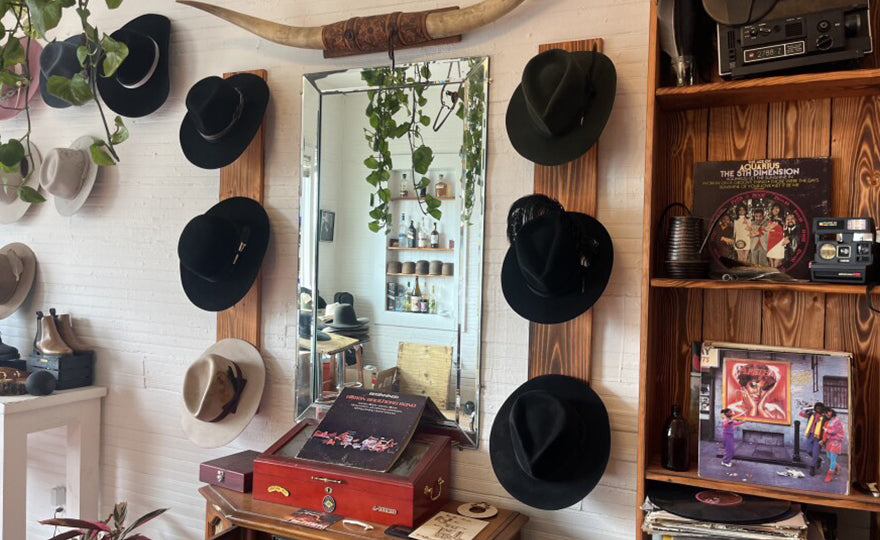
The Art of Crafting Cashmere Felt Hats: A Step-by-Step Guide to Luxurious Headwear
For centuries, felt hats have graced the heads of style icons and practical dressers alike, but nothing compares to the luxurious touch of a genuine cashmere felt hat. This comprehensive guide unveils the meticulous process behind crafting these premium accessories, answering the growing search demand for "how cashmere felt hats are made" and "luxury felt hat craftsmanship." Whether you're a fashion enthusiast, millinery student, or eco-conscious consumer seeking sustainable luxury, understanding this artisanal process will deepen your appreciation for these timeless pieces.
From Raw Fleece to Premium Fibers: Sourcing the Finest Cashmere
The journey of a cashmere felt hat begins in the rugged highlands of Mongolia and Inner Mongolia, where Capra hircus goats develop their extraordinarily soft undercoats to survive harsh winters. Unlike regular wool, cashmere fibers measure a delicate 14-19 microns in diameter (human hair averages 75 microns), creating that signature cloud-like softness discerning hat lovers crave.
Ethical sourcing has become a top priority in response to consumer searches for "sustainable cashmere hats" and "ethical felt hat brands." Reputable manufacturers now implement:
-
Responsible shearing practices (hand-combing during molting season)
-
Fair trade partnerships with herding communities
-
Fiber traceability systems from farm to finished product
The raw cashmere arrives at mills as a tangled mass containing coarse guard hairs. Through a meticulous dehairing process, workers remove these coarse fibers using specialized machines with rotating drums and precision-set teeth. What remains is the precious undercoat - about 200-300 grams per goat annually, explaining why "pure cashmere hats" command premium prices.
The Ancient Art of Felting: Transforming Fibers into Fabric
Felting remains one of humanity's oldest textile techniques, yet crafting premium cashmere felt requires both traditional knowledge and modern technology. The process begins with carding, where workers feed the cleaned fibers through a series of rotating drums covered with fine wire pins. This crucial step:
-
Aligns fibers uniformly
-
Creates airy batts (thin fiber sheets)
-
Ensures even density for consistent felting
These batts then undergo cross-layering, building up to 12 alternating layers that will shrink approximately 40% during fulling. Artisans carefully monitor fiber orientation to guarantee the finished felt's structural integrity in all directions.
The magic happens in the felting chamber, where controlled applications of:
-
Heat (140-160°F)
-
Moisture (pH-balanced soap solutions)
-
Mechanical agitation (rolling, pressing, kneading)
cause the cashmere's microscopic scales to open and interlock permanently. This irreversible process, known as full felting, transforms fragile fibers into a durable yet supple textile - answering search queries for "how is felt made from wool."
Blocking and Shaping: Where Science Meets Artistry
With the felted fabric prepared, master hatters begin the transformative blocking process that gives each hat its distinctive silhouette. Using steam at precise temperatures (avoiding the common mistake of excessive heat that damages cashmere), artisans:
-
Stretch the felt over custom-made hat blocks (typically made from aged birch or modern aluminum)
-
Set the crown shape using specialized stretching tools
-
Define the brim with tension gauges and precision trimming
Popular styles like fedoras, cloches, and trilbies each require unique blocking techniques - a fact reflected in search trends for "how to shape a felt hat" and "hat blocking tutorial." The process may involve:
-
Multiple blocking stages for complex designs
-
Hand-smoothing to eliminate wrinkles
-
Gradual drying over 24-48 hours to set the form
Contemporary manufacturers use laser-guided cutting for consistency, but premium brands maintain hand-finishing for that irreplicable human touch sought after by luxury shoppers.
Finishing Touches: From Functional to Fabulous
The final 20% of production creates 80% of the visual impact, explaining why searches for "handmade hat details" and "luxury hat finishes" continue growing. Skilled artisans now:
-
Sand the surface with fine-grit abrasives for velvety texture
-
Stitch sweatbands using curved needles and linen thread
-
Set embellishments like grosgrain ribbons or hand-rolled edges
Quality control includes:
-
Dimensional checks (crown height, brim width to 1/16" tolerance)
-
Color consistency under calibrated lighting
-
Water resistance testing (for weatherproof models)
Sustainable practices now extend to finishing, with brands offering:
-
Plant-based waterproofing instead of PFCs
-
Recycled silk linings
-
Biodegradable packaging
Caring for Your Investment: Maintenance Tips for Longevity
Understanding proper care answers common searches like "how to clean cashmere hats" and "storing felt hats properly." Manufacturers recommend:
-
Weekly maintenance: Use a soft bristle brush (always counter-clockwise) to remove dust
-
Stain treatment: Immediate spot cleaning with microfiber cloth and mild soap
-
Storage: In breathable cotton bags with cedar blocks, never hung by the brim
For deep cleaning, professional services using specialized techniques like:
-
CO2 cleaning for delicate embellishments
-
pH-balanced foam baths that preserve natural oils
-
Shape-retention drying on original blocks
Avoid common mistakes like:
-
Using regular shampoo (too alkaline)
-
Excessive handling when wet (causes distortion)
-
Storing near heat sources (dries out fibers)
The Future of Cashmere Felting: Innovation Meets Tradition
As searches grow for "sustainable luxury hats" and "high-tech millinery," the industry responds with:
-
Blockchain traceability: Letting customers verify their hat's origin story
-
3D body scanning: For perfect custom fits without multiple fittings
-
Bio-felt experiments: Exploring plant-based alternatives with similar properties
Yet traditional skills remain invaluable, with apprenticeship programs ensuring techniques like:
-
Hand-blocking nuances
-
Decorative stitching variations
-
Vintage style restoration
continue thriving in our digital age.
By understanding this journey from goat to gorgeous headwear, wearers gain deeper appreciation for their cashmere felt hats - not just as accessories, but as wearable art combining nature's finest fibers with human ingenuity. Whether you're investing in your first quality felt hat or adding to a curated collection, this knowledge helps identify truly exceptional pieces worth their premium price tags.
